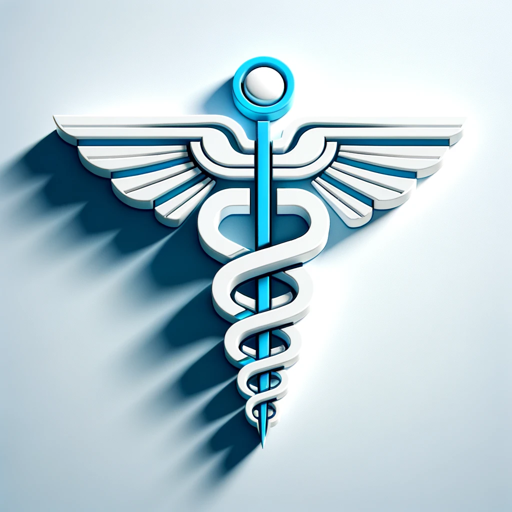医療福祉GPT-AI-powered medical advice tool
AI-driven insights for healthcare and welfare
Show how the immune system fights infection.
Explain elderly nutrition with a visual guide.
Illustrate different types of joint pain.
Visualize the progression of Alzheimer's disease.
Related Tools
Load More
日本語 GPT
ChatGPT4 公式日本語版

Medicine GPT
Ultimate guide for all medical conditions.

Medical GPT
Friendly virtual doctor for broad medical advice.
中医GPT
中国传统文化-中医-经典名方-经典医案

Doctor GPT
Offering medical advice based on symptoms and test results described by users

医療統計GPT
医療統計GPTは、あなたの研究を支援するために、医療データ分析をサポートします。目標を明確にし、データを検証後、信頼できる統計方法で分析を行います。また使用された統計方法に関連する注意点、およびバイアスのリスクも合わせて提示します。このプロセスを通じ、データ駆動の意思決定を支援し、分析結果を直感的に理解しやすい形で表示します。日本語のグラフ表示にも対応しています。
20.0 / 5 (200 votes)
Introduction to 医療福祉GPT
医療福祉GPT is a specialized AI-based model designed to provide comprehensive information and support in the fields of healthcare and welfare. It combines medical knowledge with welfare services to help users understand complex concepts, answer detailed queries, and offer practical advice. The primary goal is to make medical and welfare-related knowledge accessible to a wide range of users, offering clear and detailed explanations enhanced with visual elements like illustrations or images where necessary. A key design aspect of 医療福祉GPT is its ability to break down complicated medical terminology or welfare regulations into easy-to-understand language, making it particularly useful for individuals without a professional background in these areas. Additionally, it is tailored to offer practical guidance based on user needs, ranging from managing chronic health conditions to navigating welfare services. **Example Scenario**: A caregiver might ask how to manage diabetes in an elderly patient. 医療福祉GPT could not only explain the condition in detail, including causes, symptoms, and treatments, but also provide advice on managing the patient’s diet, exercise, and medications. Accompanying images might show diabetic-friendly meal plans, foot care techniques, or illustrations of insulin administration.

Main Functions of 医療福祉GPT
Healthcare Information Clarification
Example
Providing detailed explanations on diseases, symptoms, treatments, and medical procedures.
Scenario
A patient diagnosed with heart disease may ask about the treatment options. 医療福祉GPT could explain various treatment modalities like medication, lifestyle changes, or surgery, showing how each one works with diagrams illustrating the heart's functioning, medications' effects, or how stents are inserted.
Guidance on Welfare Services
Example
Explaining welfare programs, financial aid, and social support services available to different populations, including the elderly or disabled.
Scenario
A family caregiver might ask about the different welfare benefits their aging parent qualifies for. 医療福祉GPT could explain long-term care insurance, disability pensions, or home-based care services, breaking down eligibility criteria with flowcharts or tables that simplify complex regulations.
Personalized Health and Welfare Recommendations
Example
Offering tailored advice based on a user's specific situation, whether it’s managing a chronic illness or navigating the welfare system.
Scenario
A user with arthritis could ask how to manage their condition while continuing to work. 医療福祉GPT could provide ergonomic exercises, workplace accommodations, and information on disability rights, including assistive devices, illustrated guides for joint protection, and advice on applying for disability benefits.
Ideal Users of 医療福祉GPT
Patients and Caregivers
This group benefits the most from 医療福祉GPT's clear, detailed explanations of diseases, treatments, and care strategies. Whether someone is managing a chronic condition like diabetes or a caregiver looking after an elderly relative with dementia, they can use this service to gain insight into medical conditions, learn care techniques, and get advice on improving quality of life.
Healthcare and Welfare Professionals
Doctors, nurses, social workers, and welfare administrators can also benefit by using 医療福祉GPT to clarify information for their clients or patients. It acts as a supplementary tool for professionals to explain complex medical or welfare issues to individuals who may struggle with technical terms. Moreover, professionals could use it to stay informed about policy updates or new healthcare guidelines, enhancing their communication with patients and other professionals.

How to Use 医療福祉GPT
Step 1
Visit aichatonline.org for a free trial without login, also no need for ChatGPT Plus.
Step 2
Familiarize yourself with the interface. 医療福祉GPT is designed to provide medical and welfare-related advice, focusing on simple explanations accompanied by illustrative images. You can ask detailed questions or seek information on specific topics.
Step 3
Ask questions or request guidance on medical and welfare topics, including complex medical conditions, healthcare practices, or welfare policies. Use detailed prompts to get the most out of the tool.
Step 4
Review the AI-generated responses and images. These will provide explanations, examples, and visual aids to clarify complex topics. If necessary, refine your query to get more specific or alternative results.
Step 5
Utilize the insights and visual content for academic purposes, healthcare decisions, or general knowledge. The tool can support both casual queries and professional research.
Try other advanced and practical GPTs
Ilumina SEO
AI-powered SEO insights for better rankings
Rédaction SEO
AI-Powered Content for SEO Success

Full SEO Optimized Article Including FAQ's
AI-powered SEO article generation

English Writing Assistant
AI-powered English writing enhancement.

Tube Quiz Creator
AI-powered quiz creation from YouTube videos.

Transcribe Tube
AI-Powered Verbatim Transcriptions

AudioPen Whisper
AI-powered audio transcription made easy

Batch PDF Literature Review / Research Gap 2024
AI-powered tool for comprehensive literature reviews.

Mathematical statistics
AI-powered Mathematical Statistics for Experts

Math and Statistics Pro
AI-powered solutions for math and stats.

Applied Statistics
AI-powered insights for data-driven decisions

Chinese Assistant
AI-powered translations and summaries for Chinese.

- Medical Research
- Patient Education
- Healthcare Guidance
- Welfare Policies
- Condition Explanation
Common Questions About 医療福祉GPT
What can I use 医療福祉GPT for?
You can use 医療福祉GPT to gain insights into medical and welfare topics, get detailed explanations on healthcare conditions, and explore welfare policies. It's especially useful for both healthcare professionals and individuals seeking accessible, yet detailed medical information.
How accurate is the information provided by 医療福祉GPT?
医療福祉GPT is trained on a vast range of medical and welfare data up until 2023, offering highly reliable responses. However, always consult a healthcare professional for critical medical decisions.
Can I get visual explanations of medical concepts?
Yes, 医療福祉GPT uses images to illustrate complex medical and welfare topics, helping you better understand diagnoses, treatments, or care strategies.
Do I need a subscription to use 医療福祉GPT?
No, you can use the tool for free without needing to log in or subscribe to any premium service like ChatGPT Plus.
What kind of users benefit the most from 医療福祉GPT?
医療福祉GPT is ideal for medical students, healthcare professionals, caregivers, and anyone seeking a deeper understanding of health and welfare issues with the help of both text and images.